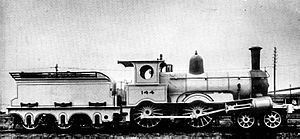Class of Australian 4-4-0 locomotives From Wikipedia, the free encyclopedia
The New South Wales Z12 class was a class of 4-4-0 steam locomotives operated by the New South Wales Government Railways of Australia.
| New South Wales Z12 class | |||||||||||||||||||||||||||||
|---|---|---|---|---|---|---|---|---|---|---|---|---|---|---|---|---|---|---|---|---|---|---|---|---|---|---|---|---|---|
 | |||||||||||||||||||||||||||||
| |||||||||||||||||||||||||||||
| |||||||||||||||||||||||||||||
| |||||||||||||||||||||||||||||
| |||||||||||||||||||||||||||||



The Z12 class (formerly C79 and C80 class) was the first class of locomotive on the New South Wales Government Railways to be built in relatively large numbers. They hauled all express passenger and mail trains for some 20 years.
The design derives from the Metropolitan Railway A Class 4-4-0T condensing steam locomotives built for the Metropolitan Railway by Beyer, Peacock & Company in 1864. The design of these locomotives was attributed to the Metropolitan Engineer John Fowler, but the design was a development of a locomotive Beyers had built for the Spanish Tudela & Bilbao Railway, Fowler only specifying the driving wheel diameter, axle weight and the ability to navigate sharp curves.[1]
A total of 68 were built. The first batch of 30 were built by Beyer, Peacock & Company and placed in service as the 79 class between 1877 and 1879. They were the first locomotives to be imported with Westinghouse continuous air-brakes already fitted. The second batch of 26 came from Dübs & Company. These arrived between 1880 and 1881. A further four followed from Beyer, Peacock in 1881. To assist local industry, a contract for eight was awarded to the Atlas Engineering Works, Haymarket and delivered in 1881–1882.[2][3]
Their numbers were thinned from 1895 when No. 88 was converted at Eveleigh Railway Workshops to a 4-4-2T tank engine for Sydney suburban service with a further 19 following by 1902. These were reclassified the CC79 class. The remaining engines became the C80 class.
The arrival of newer locomotives such as the D255, D261, O446 and P6 classes saw them relegated to hauling secondary and later branch line services radiating out of Dubbo, Werris Creek, Narrabri and Moree, where some were equipped with cowcatchers for operation on unfenced lines. In an attempt to prevent cinders blocking the lower boiler tubes between cleanings in December 1956 an extended smokebox was fitted to 1219 with 1243 similarly modified in the 1960s.[3][4][5]
As part of the 1924 reclassification scheme, the remaining 48 members of the class were reclassified as the Z12 class and renumbered 1201 to 1248. With the conversion of 77 C30 class suburban tank engines (made redundant by electrification) into C30T class 4-6-0s, withdrawals begin with 23 taken out of service between 1928 and 1933. Many of the others survived into the 1950s hauling branch line services.[5]
The first two withdrawals occurred in 1957, a further four followed in 1963.
In 1955, for the centenary of rail operations in New South Wales, 1243 was restored to its original livery. It was joined by 1210 in December 1959 and together these hauled the Vintage Train across the state.[4][5][6]
Three have been preserved:
Seamless Wikipedia browsing. On steroids.